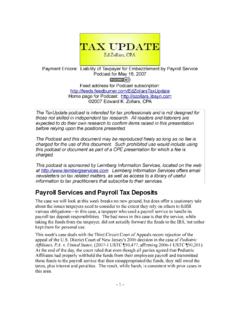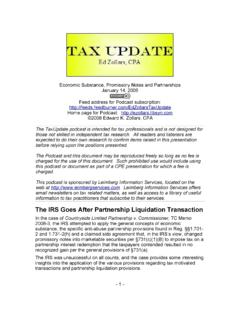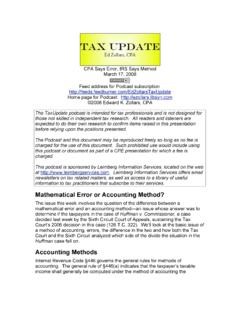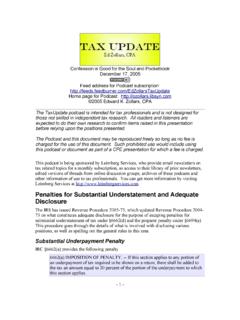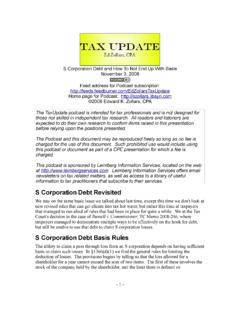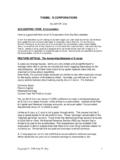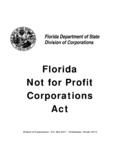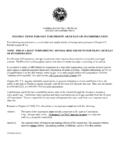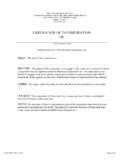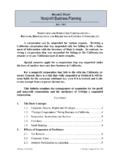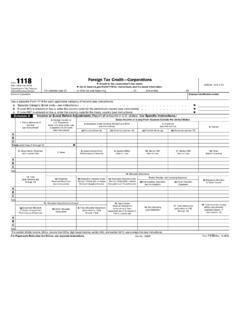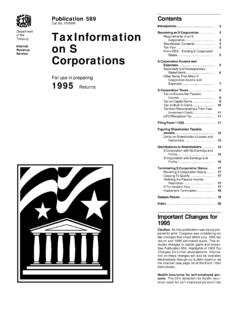Transcription of S Corporations and AAA - Ed Zollars
1 S Corporations and the AAA AccountJuly 7, 2008 Feed address for Podcast subscription: page for Podcast: 2008 Edward K. Zollars , CPAThe TaxUpdate podcast is intended for tax professionals and is not designed for those not skilled in independent tax research. All readers and listeners are expected to do their own research to confirm items raised in this presentation before relying upon the positions presented. The Podcast and this document may be reproduced freely so long as no fee is charged for the use of this document. Such prohibited use would include using this podcast or document as part of a CPE presentation for which a fee is podcast is sponsored by Leimberg Information Services, located on the web at Leimberg Information Services offers email newsletters on tax related matters, as well as access to a library of useful information to tax practitioners that subscribe to their Corporations and AAAThe IRS issued some guidance regarding handling an account that generates a bit of confusion with regard to S Corporations the accumulated adjustments account we find defined in IRC 1368(e)(1) and its relevance and impact on S Corporations and their shareholders.
2 What the IRS addressed was the issue of what happens for AAA purposes if the S corporation pays for key man life insurance, both in the case when the premiums are paid and when proceeds from the policy are received. The IRS issued Revenue Ruling 2008-42 to explain the impact in that we'll review includes the overall importance of AAA, its relationship (or lack thereof) to shareholder basis in the shareholders' shares, and how we go about computing it (including the notice described above).- 1 -S Corporations and the AAA AccountPodcast of July 7, 2008 's RelevanceThe actual definition of the accumulated adjustments account is found in IRC 1368, which deals with distributions from an S corporation . That section starts out with the following provision in 1368(a):(a) General rule A distribution of property made by an S corporation with respect to its stock to which (but for this subsection) section 301(c) would apply shall be treated in the manner provided in subsection (b) or (c), whichever 301(c) generally deals with distributions from a corporation in the ordinary course of business.
3 Such distributions will be considered taxable dividends under 316 to the extent of the corporation 's earnings and profits, either since inception (presuming inception is after February 28, 1913, generally the case for my clients) or out of current year earnings and profits. If both of those items are exhausted by the distribution (or were zero before the distribution), 301(c) provides that the distribution will apply against the shareholder's basis in the stock [ 301(c)(2)] and, when basis is exhausted, be treated as gain from the sale or exchange of property (subject to another pre-1913 appreciation rule we'll generally not worry about at this date) [ 301(c)(3)].No Earnings and ProfitsS corporation distributions fall into two categories. For an S corporation without earnings and profits, the rule is very simple and no reference is made to the accumulated adjustments account.
4 This case is covered by 1368(b) which provides:(b) S corporation having no earnings and profitsIn the case of a distribution described in subsection (a) by an S corporation which has no accumulated earnings and profits--(1) Amount applied against basisThe distribution shall not be included in gross income to the extent that it does not exceed the adjusted basis of the stock.(2) Amount in excess of basisIf the amount of the distribution exceeds the adjusted basis of the stock, such excess shall be treated as gain from the sale or exchange of you may note, the application becomes very similar to what we see for C corporation distributions where there are no earnings and profits (absent the pre-1913 provisions). - 2 -S Corporations and the AAA AccountPodcast of July 7, 2008 first recover stock basis (note that debt basis doesn't enter into this calculation) and then have a gain from the sale or exchange of the S corporation shareholder's basis modifications over time are governed by 1367, with 1367(a)(1) providing for items that increase a shareholders' basis:(1) Increases in basisThe basis of each shareholder's stock in an S corporation shall be increased for any period by the sum of the following items determined with respect to that shareholder for such period:(A) the items of income described in subparagraph (A) of section 1366(a)(1),(B) any nonseparately computed income determined under subparagraph (B) of section 1366(a)(1), and(C) the excess of the deductions for depletion over the basis of the property subject to in basis are covered by 1367(a)(2), which provides.
5 (2) Decreases in basisThe basis of each shareholder's stock in an S corporation shall be decreased for any period (but not below zero) by the sum of the following items determined with respect to the shareholder for such period:(A) distributions by the corporation which were not includible in the income of the shareholder by reason of section 1368,(B) the items of loss and deduction described in subparagraph (A) of section 1366(a)(1),(C) any nonseparately computed loss determined under subparagraph (B) of section 1366(a)(1),(D) any expense of the corporation not deductible in computing its taxable income and not properly chargeable to capital account, and(E) the amount of the shareholder's deduction for depletion for any oil and gas property held by the S corporation to the extent such deduction does not exceed the proportionate share of the adjusted basis of such property allocated to such shareholder under section 613A(c)(11)(B).
6 As always, basis cannot be pushed below zero if the math would cause that to happen, we end up with either losses held back due to lack of basis or taxable gain events (when distributions exceed basis).- 3 -S Corporations and the AAA AccountPodcast of July 7, 2008 (f) provides an ordering rule on how to apply these adjustments, an ordering that used to be different for tax years beginning prior to August 18, 1998 (so if you last looked into this a decade ago, your knowledge would be a bit dated):(f) Ordering rules for taxable years beginning on or after august 18, any taxable year of a corporation beginning on or after August 18, 1998, except as provided in paragraph (g) of this section, the adjustments required by section 1367(a) are made in the following order --(1) Any increase in basis attributable to the income items described in section 1367(a)(1)(A) and (B), and the excess of the deductions for depletion described in section 1367(a)(1)(C);(2) Any decrease in basis attributable to a distribution by the corporation described in section 1367(a)(2)(A).
7 (3) Any decrease in basis attributable to noncapital, nondeductible expenses described in section 1367(a)(2)(D), and the oil and gas depletion deduction described in section 1367 (a)(2)(E);(4) Any decrease in basis attributable to items of loss or deduction described in section 1367(a)(2)(B) and (C).Note that a shareholder gets credit for increases first, then we take the distributions and only after those come out does basis get reduced by the items that decrease basis. What that means is that, effectively, if the shareholder has basis at the beginning of the year, the shareholder won't exhaust basis by taking a distribution during the year up to that amount of basis. Prior to the effective date of this new ordering rule (generally for 1999 and later calendar years) that wasn't the case, as distributions came out last under the old today's podcast what is important to note is that, at this point, we've had no mention at all of the accumulated adjustments account and that's because, as will become clear, AAA's purpose is let us know when we distributing out earnings and profits from the corporation .
8 A corporation with no E&P does not have an issue with AAA. A corporation that has always been an S corporation since inception, and which came into being after the 1982 S corporation Act would not have such earnings and profits unless it somehow picked up the taint of a C corporation (perhaps via merging with it).Earnings and Profits and AAAAAA finally appears in the Internal Revenue Code when we get to 1368(c), which provides:- 4 -S Corporations and the AAA AccountPodcast of July 7, 2008 (c) S corporation having earnings and profitsIn the case of a distribution described in subsection (a) by an S corporation which has accumulated earnings and profits--(1) Accumulated adjustments accountThat portion of the distribution which does not exceed the accumulated adjustments account shall be treated in the manner provided by subsection (b).(2) DividendThat portion of the distribution which remains after the application of paragraph (1) shall be treated as a dividend to the extent it does not exceed the accumulated earnings and profits of the S corporation .
9 (3) Treatment of remainderAny portion of the distribution remaining after the application of paragraph (2) of this subsection shall be treated in the manner provided by subsection (b).Except to the extent provided in regulations, if the distributions during the taxable year exceed the amount in the accumulated adjustments account at the close of the taxable year, for purposes of this subsection, the balance of such account shall be allocated among such distributions in proportion to their respective sizes. Note that 1368(b), which ignores the AAA account, governs distributions generally except for the band covered by 1368(c)(2) which handles the treatment of the earnings and profits. As well, note this is a corporate determination and not one done at the shareholder level. Contrast that with the basis provisions of 1367, which is a shareholder determination. That difference is a key matter to understand to consider the relevance of accumulated adjustments account is defined in 1368(e)(1)(A) in general, which provides the following:(A) In generalExcept as otherwise provided in this subparagraph, the term "accumulated adjustments account" means an account of the S corporation which is adjusted for the S period in a manner similar to the adjustments under section 1367 (except that no adjustment shall be made for income (and related expenses) which is exempt from tax under this title and the phrase "(but not below zero)" shall be disregarded in section 1367(a)(2) and no adjustment shall be made for Federal taxes attributable to any taxable year in which the corporation was a C corporation .)
10 - 5 -S Corporations and the AAA AccountPodcast of July 7, 2008 is important to remember that while AAA is defined by reference to the basis adjustment items in 1367, it excludes nontaxable income and nondeductible expenses, and it is a corporate calculation. What that means is that there is no direct link between total shareholder basis and the accumulated adjustments account and any attempt to reconcile the concepts is going to face a number of special adjustments, especially for any case of anything more than an extremely simple S well, as we'll note below, the fact that nontaxable income doesn't add to AAA (though it does increase basis) means that such income (net of expenses related to tax exempt income) is trapped below any earnings and profits that might exist for purposes of distributions. This particular issue was the matter the IRS ruled upon in the Revenue Ruling 2008-42 issued this special adjustment is defined in 1368(e)(1)(B) for the cases of redemptions:(B) Amount of adjustment in the case of redemptionsIn the case of any redemption which is treated as an exchange under section 302(a) or 303(a), the adjustment in the accumulated adjustments account shall be an amount which bears the same ratio to the balance in such account as the number of shares redeemed in such redemption bears to the number of shares of stock in the corporation immediately before such redemption.

